
| January 2002 | ||||||
| Sun | Mon | Tue | Wed | Thu | Fri | Sat |
| 1 | 2 | 3 | 4 | 5 | ||
| 6 | 7 | 8 | 9 | 10 | 11 | 12 |
| 13 | 14 | 15 | 16 | 17 | 18 | 19 |
| 20 | 21 | 22 | 23 | 24 | 25 | 26 |
| 27 | 28 | 29 | 30 | 31 | ||
Friday 18 January 2002
At 1200, EST the Training Ship Empire State was located at 30 degrees and 47 minutes North Latitude and 077 degrees 18 minutes West Longitude, enroute to the Fort Lauderdale, Florida anchorage. Jacksonville, Florida bears 260 degrees at 230 nautical miles. She was on a course of 206 degrees true traveling at a speed of 14 knots. Winds were from the southwest at 12 knots, air temperature was 76 degrees Fahrenheit, barometric pressure was 1020 millibars, seas were from the southwest at 3 to 5 feet, sea injection temperature was 74 degrees Fahrenheit. Depth of water beneath the keel was 630 fathoms.
CAPTAIN'S LOG
"When you arise in the morning, give thanks for the morning light, for your life and strength. Give thanks for your food, and the joy of living. If you see no reason for giving thanks, the fault lies with yourself." Tecumseh (1768-1813) Shawnee Chief
We spent a quiet night leisurely steaming into more hospitable climes. The deep, blue-green waters beneath us are rapidly warming and the air above is becoming heavy with tropical moisture. The powerful northerly currents of the rushing Gulf Stream restrain our forward progress somewhat, but we gladly trade haste for the heat that rides the warm tropical flow. The storm of Sunday past continues to dominate casual chatter but that topic is old news. It is being replaced by mysterious scuttlebutt; tales that surround "The Devil's Triangle". Far be it from us to foster such nonsense... but for a little fun:
The Bermuda or Devil's Triangle is not an official name recognized by anyone in the sea going industry or by any cartographer. However, this imaginary area of myth and legend is bounded by a line drawn northeasterly from Miami to Bermuda, south to San Juan, Puerto Rico, and northwest to Florida. Most aboard are familiar with the highly publicized losses over the years of ships, planes, pleasure craft, surf boards, etc. that have been recorded in this large expanse of ocean. When one combines a liberal dose of sea going inexperience, the recent memory of a good strong storm, and the mystical power of long standing myth... standby for fun. As with all good sea stories, the potential ill effects of sailing in this supernatural piece of ocean are constrained only by the limits of the human imagination; don't confuse a believer with the facts. As luck would have it, we are proceeeding directly into harm's way- an anchorage within the "boundries" of the Bermuda Triangle.
Despite the "danger", training goes on without stop. For newcomers to this page, an explanation is required. All cadets are divided into three divisions. Each division is assigned a different daily responsibility: Training, Watch or Maintenance. Today's topic for discussion is training.
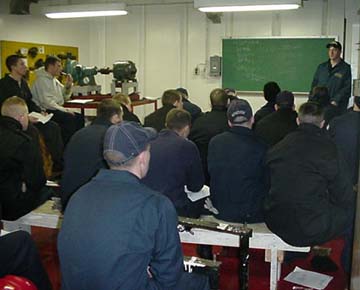
Upper class cadets, who have decided upon a major course of study, will train in their respective professional courses. For example, Deck cadets study subjects such as sun lines, rules of the road, celestial position fixing, and piloting.
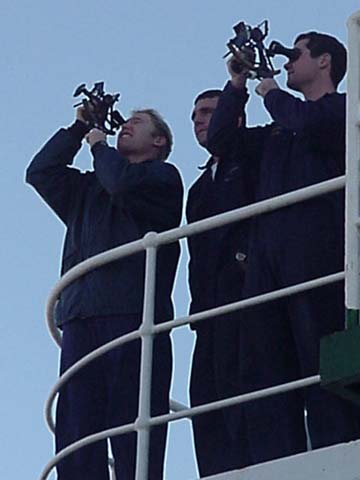
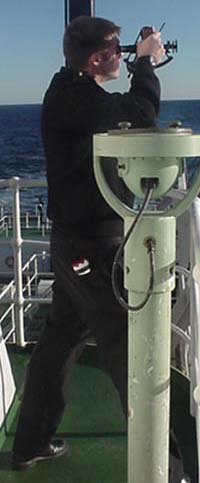
Engine cadets study boilers, turbines,and mechanical systems. MSEP cadets study oil pollution laws, ichthyology, and marine biology.
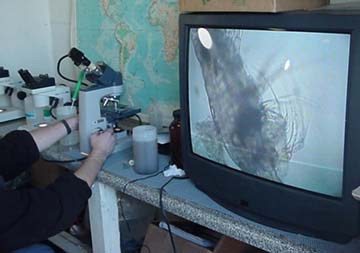
International Maritime Business cadets work on intermodal transportation problems, admiralty law, customs regulations, and ship's construction. Freshmen cadets get a little bit of all of the above as we endeavor to show them the entire spectrum of opportunities offered at MMA before they make their choice of major.
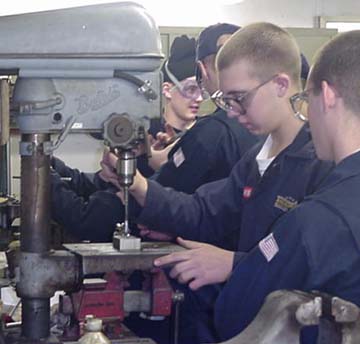
Although technically a 6 credit college course with a mid-term exam, homework, and final exam, the sea term is primarily focused on the practical side of the profession. Hands on applications are what we strive for out here; to bring the lessons learned in the classroom to life. Training is what "drives" the schedule of departures/arrivals and the track of the ship through the sea. Training determines the pulse of the day at sea. It causes us to come to a complete stop to fetch samples from the water column and slowly drag plankton nets from the stern. (Much to the consternation of the engine gang who don't like to stop machines that are working perfectly fine, thank you very much.) Training causes us to maneuver close to shore so that deckies can fix their position by reference to lighthouses and other terrestrial references. (Much to the consternation of the Captain who likes it when there is nothing at all on the radar screens for a hundred miles in all directions.)In short, Training is our "Raison d'etre".
CADET'S COMMENT
ANSWERS FOR FRIDAY 18 JANUARY 2002
MATH: 7/8 = the decimal .875
.875 = 87.5 percent
495 x .875 = 433
SCIENCE: Energy moves through the atmosphere by conduction, convection, and radiation.
GEOGRAPHY: The area around Cape Hatteras, North Carolina is known as the Graveyard of the Atlantic.
HISTORY: The bill was finally passed by both the House of Representatives and the Senate and was signed into law by President Ronald Reagan on November 2, 1983. The first national celebration of the Dr. Martin Luther King, Jr. Holiday took place January 20, 1986.